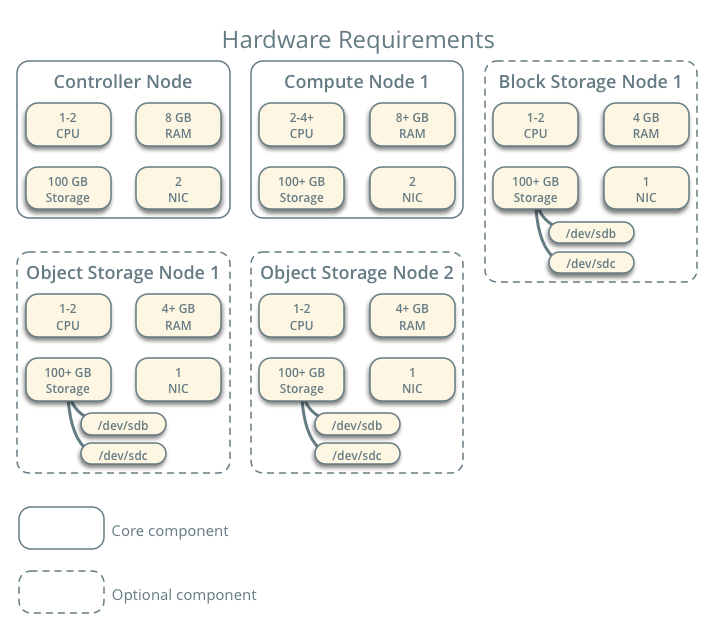As per bug, making the purpose of the guide clearer, ensuring readers understand it is a minimum architecture for PoC purposes, and directing them to the arch guide for more complicated archictures. Change-Id: Ibeea8a6e8fa279d75c656c8073d2a1197b177fe3 Closes-Bug: #1646249
6.5 KiB
Overview
The OpenStack
project is an open source cloud computing platform that supports all
types of cloud environments. The project aims for simple implementation,
massive scalability, and a rich set of features. Cloud computing experts
from around the world contribute to the project.
OpenStack provides an Infrastructure-as-a-Service (IaaS) solution through a
variety of complementary services. Each service offers an Application Programming Interface (API) that
facilitates this integration.
This guide covers step-by-step deployment of the major OpenStack services using a functional example architecture suitable for new users of OpenStack with sufficient Linux experience. This guide is not intended to be used for production system installations, but to create a minimum proof-of-concept for the purpose of learning about OpenStack.
After becoming familiar with basic installation, configuration, operation, and troubleshooting of these OpenStack services, you should consider the following steps toward deployment using a production architecture:
- Determine and implement the necessary core and optional services to meet performance and redundancy requirements.
- Increase security using methods such as firewalls, encryption, and service policies.
- Implement a deployment tool such as Ansible, Chef, Puppet, or Salt to automate deployment and management of the production environment.
Example architecture
The example architecture requires at least two nodes (hosts) to
launch a basic virtual machine <virtual machine (VM)> or
instance. Optional services such as Block Storage and Object Storage
require additional nodes.
Important
The example architecture used in this guide is a minimum configuration, and is not intended for production system installations. It is designed to provide a minimum proof-of-concept for the purpose of learning about OpenStack. For information on creating architectures for specific use cases, or how to determine which architecture is required, see the Architecture Design Guide.
This example architecture differs from a minimal production architecture as follows:
- Networking agents reside on the controller node instead of one or more dedicated network nodes.
- Overlay (tunnel) traffic for self-service networks traverses the management network instead of a dedicated network.
For more information on production architectures, see the Architecture Design Guide, OpenStack Operations Guide, and OpenStack Networking Guide.
Controller
The controller node runs the Identity service, Image service,
management portions of Compute, management portion of Networking,
various Networking agents, and the Dashboard. It also includes
supporting services such as an SQL database, message queue, and NTP <Network Time Protocol
(NTP)>.
Optionally, the controller node runs portions of the Block Storage, Object Storage, Orchestration, and Telemetry services.
The controller node requires a minimum of two network interfaces.
Compute
The compute node runs the hypervisor portion of Compute that operates
instances. By default, Compute uses the KVM <kernel-based VM (KVM)> hypervisor. The
compute node also runs a Networking service agent that connects
instances to virtual networks and provides firewalling services to
instances via security groups <security group>.
You can deploy more than one compute node. Each node requires a minimum of two network interfaces.
Block Storage
The optional Block Storage node contains the disks that the Block Storage and Shared File System services provision for instances.
For simplicity, service traffic between compute nodes and this node uses the management network. Production environments should implement a separate storage network to increase performance and security.
You can deploy more than one block storage node. Each node requires a minimum of one network interface.
Object Storage
The optional Object Storage node contain the disks that the Object Storage service uses for storing accounts, containers, and objects.
For simplicity, service traffic between compute nodes and this node uses the management network. Production environments should implement a separate storage network to increase performance and security.
This service requires two nodes. Each node requires a minimum of one network interface. You can deploy more than two object storage nodes.
Networking
Choose one of the following virtual networking options.
Networking Option 1: Provider networks
The provider networks option deploys the OpenStack Networking service
in the simplest way possible with primarily layer-2 (bridging/switching)
services and VLAN segmentation of networks. Essentially, it bridges
virtual networks to physical networks and relies on physical network
infrastructure for layer-3 (routing) services. Additionally, a DHCP<Dynamic Host
Configuration Protocol (DHCP)> service provides IP address
information to instances.
Warning
This option lacks support for self-service (private) networks,
layer-3 (routing) services, and advanced services such as LBaaS <Load-Balancer-as-a-Service (LBaaS)> and
FWaaS<FireWall-as-a-Service (FWaaS)>. Consider
the self-service networks option below if you desire these features.
Networking Option 2: Self-service networks
The self-service networks option augments the provider networks
option with layer-3 (routing) services that enable self-service networks using
overlay segmentation methods such as VXLAN <Virtual Extensible LAN (VXLAN)>.
Essentially, it routes virtual networks to physical networks using NAT<Network Address
Translation (NAT)>. Additionally, this option provides the
foundation for advanced services such as LBaaS and FWaaS.


